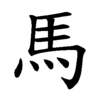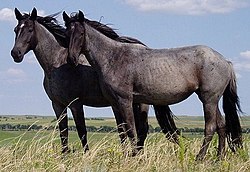馬: difference between revisions
→Derived terms: Fixed link Tag: 2017 source edit |
|||
| Line 144: | Line 144: | ||
{{ja-kanjitab|うま|yomi=k}} |
{{ja-kanjitab|うま|yomi=k}} |
||
From {{inh|ja|ojp|-|sort=うま}}.<ref name="KDJ">{{R:Kokugo Dai Jiten}}</ref> Recorded in the [[w:Nihon Shoki|Nihon Shoki]] of 720 {{CE}} as having been brought over from the Korean peninsula kingdom of [[w:Baekje|Baekje]], with the earlier reading of ''ma''. The initial ''m'' sound was apparently emphasized,<ref name="KDJ">{{R:Kokugo Dai Jiten}}</ref><ref name="DJR">{{R:Daijirin}}</ref> possibly similar to ''*mma'', becoming then ''uma'' or ''muma'', via processes also seen in the word {{m|ja|梅|tr=ume, mume|t=plum}}. |
From {{inh|ja|ojp|-|sort=うま}}.<ref name="KDJ">{{R:Kokugo Dai Jiten}}</ref> Recorded in the [[w:Nihon Shoki|Nihon Shoki]] of 720 {{CE}} as having been brought over from the Korean peninsula kingdom of [[w:Baekje|Baekje]], with the earlier reading of ''ma''. The initial ''m'' sound was apparently emphasized,<ref name="KDJ">{{R:Kokugo Dai Jiten}}</ref><ref name="DJR">{{R:Daijirin}}</ref> possibly similar to ''*mma'', becoming then ''uma'' or ''muma'', via processes also seen in the word {{m|ja|梅|tr=ume, mume|t=plum}}. However, Pellard simply reconstructs {{cog|jpx-pro|*uma}} and explains the mentioned processes as secondary.<ref>{{cite-journal|last=Pellard|first=Thomas|title=Ryukyuan perspectives on the proto-Japonic vowel system|url=https://hal.archives-ouvertes.fr/hal-01289288/file/Pellard_2013_Ryukyuan_perspectives_on_the_proto-Japonic_vowel_system.pdf|editors=Frellesvig, Bjarke; Sells, Peter|journal=Japanese/Korean Linguistics|issue=20|publisher=CSLI Publications|year=2013|page=85|isbn=978-1-57586-638-3}}</ref> |
||
The ''ma'' sound denoting "horse" is common to a number of languages of central Asia, where horses were first domesticated, suggesting a possible cognate root. Compare {{cog|mnc|ᠮᠣᡵᡳᠨ|t=horse}}, {{cog|mn|морь|t=horse}}, {{cog|ko|말|t=horse}}, {{cog|cmn|馬|tr=mǎ|t=horse}}, and {{cog|ine-pro|*márkos|t=horse}} and descendants such as {{cog|ga|marc|t=horse|pos=archaic}} or {{cog|en|mare|t=female horse}}. More at {{m|ine-pro|*márkos}}. |
The ''ma'' sound denoting "horse" is common to a number of languages of central Asia, where horses were first domesticated, suggesting a possible cognate root. Compare {{cog|mnc|ᠮᠣᡵᡳᠨ|t=horse}}, {{cog|mn|морь|t=horse}}, {{cog|ko|말|t=horse}}, {{cog|cmn|馬|tr=mǎ|t=horse}}, and {{cog|ine-pro|*márkos|t=horse}} and descendants such as {{cog|ga|marc|t=horse|pos=archaic}} or {{cog|en|mare|t=female horse}}. More at {{m|ine-pro|*márkos}}. |
||
Revision as of 12:44, 10 March 2021
| ||||||||
| ||||||||
Translingual
| Stroke order | |||
|---|---|---|---|

| |||
| Stroke order (Hong Kong) | |||
|---|---|---|---|

| |||
Han character
馬 (Kangxi radical 187, 馬+0, 10 strokes, cangjie input 尸手尸火 (SQSF), four-corner 71327, composition ⿹⿺㇉⿻三丨灬)
- Kangxi radical #187, ⾺.
Derived characters
- Index:Chinese radical/馬
- 傌(㐷), 馮(冯), 嗎(吗), 媽(妈), 榪(杩), 瑪(玛), 溤, 獁(犸), 碼(码), 禡(祃), 螞(蚂), 鎷(𨰾), 䣕, 遤, 㾺(𬏜), 罵/駡(骂), 闖(闯), 褭(𬡇)
Related characters
References
- Kangxi Dictionary: page 1433, character 1
- Dai Kanwa Jiten: character 44572
- Dae Jaweon: page 1956, character 34
- Hanyu Da Zidian (first edition): volume 7, page 4539, character 1
- Unihan data for U+99AC
Chinese
Glyph origin
| Historical forms of the character 馬 | |||||||||||
|---|---|---|---|---|---|---|---|---|---|---|---|
| Shang | Western Zhou | Spring and Autumn | Warring States | Shuowen Jiezi (compiled in Han) | Liushutong (compiled in Ming) | Libian (compiled in Qing) | |||||
| Bronze inscriptions | Oracle bone script | Bronze inscriptions | Bronze inscriptions | Bronze inscriptions | Chu slip and silk script | Qin slip script | Shizhoupian script | Ancient script | Small seal script | Transcribed ancient scripts | Clerical script |

|

|

|

|

|

|

|

|

|

|

|

|
| Semi-cursive script | Cursive script |
|---|---|

|

|
Pictogram (象形) – a horse with its head facing the left, showing a flowing mane in the wind. In the bronze inscriptions, the head was often simplified into an eye (目). The legs eventually evolved into four dots (灬, unrelated to 火).
Contrast with 鹿 (“deer”), which saw a very different development, and 𢊁 (as in 薦), which is a hybrid: it has the legs of 馬 (灬) but the head of 鹿.
Etymology
| trad. | 馬 | |
|---|---|---|
| simp. | 马 | |
| alternative forms | ||
“Horse” – from Proto-Sino-Tibetan *k-m-raŋ ~ s-raŋ. The sense of “big” is derived from “horse”; compare the English uses of horse.
For the insect prefix sense, see 螞. It has converged with the sense of “big”.
The surname is popularly known to be prevalent among Hui Muslims, where it is likely derived from Arabic مُحَمَّد (muḥammad, “Muhammad”).
Pronunciation
Lua error in Module:wuu-pron at line 195: Incorrect tone notation "3" for sh. See WT:AZH/Wu.
Definitions
- horse (Classifier: 匹 m; 隻/只 m c)
- horse-shaped
- (chess) knight
- (xiangqi) knight; horse (on the black side)
- Original form of 碼/码 (mǎ, “chip for counting”).
- big (prefix for nouns)
- (Southwestern Mandarin, including Sichuanese) to bully
- (Sichuanese) to keep a straight face
- Prefix for names of insects, also written as 螞.
- Short for 馬祖/马祖 (Mǎzǔ).
- Short for 馬來西亞/马来西亚 (Mǎláixīyà).
- Lua error in Module:names at line 633: dot= and nodot= are no longer supported in Template:surname because a trailing period is no longer added by default; if you want it, add it explicitly after the template, particularly common among Hui Muslims
- 馬英九/马英九 ― Mǎ Yīngjiǔ ― Ma Ying-jeou (President of the Republic of China (Taiwan), 2008-2016)
- (~村) Ma (a village in Dongsong, Luoning, Luoyang, Henan, China)
Synonyms
Coordinate terms
- (Chinese chess pieces) 帥/帅 (shuài) / 將/将, 仕 (shì) / 士 (shì), 相 / 象 (xiàng), 俥/伡 / 車/车, 傌 / 㐷 / 馬/马 (mǎ), 炮 / 砲/炮, 兵 (bīng) / 卒
Compounds
Descendants
Others:
- Lua error in Module:etymology/templates/descendant at line 290: You specified a term in 4= and not one in 3=. You probably meant to use t= to specify a gloss instead. If you intended to specify two terms, put the second term in 3=.
- Lua error in Module:etymology/templates/descendant at line 290: You specified a term in 4= and not one in 3=. You probably meant to use t= to specify a gloss instead. If you intended to specify two terms, put the second term in 3=. (via Teochew)
References
- “馬”, in 漢語多功能字庫 (Multi-function Chinese Character Database)[2], 香港中文大學 (the Chinese University of Hong Kong), 2014–
- “Entry #6822”, in 教育部臺灣台語常用詞辭典 [Dictionary of Frequently-Used Taiwan Minnan] (overall work in Mandarin and Hokkien), Ministry of Education, R.O.C., 2024.
Japanese
Kanji
| Stroke order (Japan) | |||
|---|---|---|---|

| |||
Readings
Compounds
Etymology 1

| Kanji in this term |
|---|
| 馬 |
| うま Grade: 2 |
| kun'yomi |
From Old Japanese.[1] Recorded in the Nihon Shoki of 720 CE as having been brought over from the Korean peninsula kingdom of Baekje, with the earlier reading of ma. The initial m sound was apparently emphasized,[1][2] possibly similar to *mma, becoming then uma or muma, via processes also seen in the word 梅 (ume, mume, “plum”). However, Pellard simply reconstructs Proto-Japonic *uma and explains the mentioned processes as secondary.[3]
The ma sound denoting "horse" is common to a number of languages of central Asia, where horses were first domesticated, suggesting a possible cognate root. Compare Manchu ᠮᠣᡵᡳᠨ (morin, “horse”), Mongolian морь (morʹ, “horse”), Korean 말 (mal, “horse”), Mandarin 馬/马 (mǎ, “horse”), and Proto-Indo-European *márkos (“horse”) and descendants such as Irish marc (“horse”, archaic) or English mare (“female horse”). More at *márkos.
Pronunciation
Noun
- a horse
- (shogi) a promoted bishop
- a sawhorse: a four-leg stand made of wood or iron for supporting other materials
Usage notes
As with many terms that name organisms, this term is often spelled in katakana, especially in biological contexts (where katakana is customary), as ウマ.
Etymology 2
| Kanji in this term |
|---|
| 馬 |
| むま Grade: 2 |
| kun'yomi |
Shift from uma form, becoming more common starting from the Heian Period.[1] This change later reverted, and muma is now considered obsolete.
Pronunciation
Noun
- (obsolete) a horse
-
- 阿志加良能 美佐可多麻波理 可閇理美須 阿例波久江由久 阿良志乎母 多志夜波婆可流 不破乃世伎 久江弖和波由久 牟麻能都米 都久志能佐伎尓 知麻利為弖 阿例波伊波々牟 母呂々々波 佐祁久等麻乎須 可閇利久麻弖尓
- (please add an English translation of this quotation)
- c. 935 Tosa Nikki
- ふぢはらのときざね、ふなぢなれど、むまのはなむけす。
- (please add an English translation of this quotation)
- c. 935 Tosa Nikki
- けふはあをむまをおもへど、かひなし。
- (please add an English translation of this quotation)
-
Etymology 3
| Kanji in this term |
|---|
| 馬 |
| ば Grade: 2 |
| kan'on |
From Middle Chinese 馬 (MC maeX). The 漢音 (kan'on), so a later borrowing. Compare Min Nan 馬/马 (bé, bée, má) where some of the readings show a shift from initial nasal /m-/ to voiced plosive /b-/.
Pronunciation
Affix
- horse
- 競馬
- keiba
- horse racing
- 競馬
References
- ↑ 1.0 1.1 1.2 Shōgaku Tosho (1988) 国語大辞典(新装版) [Unabridged Dictionary of Japanese (Revised Edition)] (in Japanese), Tōkyō: Shogakukan, →ISBN
- ↑ 2.0 2.1 Matsumura, Akira, editor (2006), 大辞林 [Daijirin] (in Japanese), Third edition, Tokyo: Sanseidō, →ISBN
- ^ Pellard, Thomas (2013) “Ryukyuan perspectives on the proto-Japonic vowel system”, in Frellesvig, Bjarke, Sells, Peter, editors, Japanese/Korean Linguistics[1], number 20, CSLI Publications, →ISBN, page 85
- ^ NHK Broadcasting Culture Research Institute, editor (1998), NHK日本語発音アクセント辞典 [NHK Japanese Pronunciation Accent Dictionary] (in Japanese), Tokyo: NHK Publishing, Inc., →ISBN
Korean
Hanja
馬 (eumhun 말 마 (mal ma))
馬 (eumhun 성 마 (seong ma))
Compounds
See also
- 말 (mal)
Vietnamese
Han character
馬: Hán Việt readings: mã (
馬: Nôm readings: mựa[1][2][6][4][5][7], mã[1][2][4][5][7], mở[1][2][3], mứa[6][5][7], mả[1][2], mỡ[1], ngựa[2]
Etymology 1
Noun
Derived terms
Etymology 2
Adjective
Etymology 3
Verb
Etymology 4
Noun
- Nôm form of mả (“tomb; grave”).
- 1916, Nguyễn Đình Chiểu, Lục Vân Tiên (蓼雲僊) [Tale of Lục Vân Tiên], lines 921–922:
小 童 庄 及 哙 㗍 𦣰 陵 边 馬 哭 嘆 徘 徊 - Before the page has a chance to pay a visit,
He throws himself down upon the grave, crying, lamenting, fretting.
- Before the page has a chance to pay a visit,
Etymology 5
Verb
Etymology 6
Noun
References
- CJK Unified Ideographs block
- Han script characters
- Kangxi Radicals block
- Han character radicals
- Translingual lemmas
- Translingual symbols
- Han pictograms
- Chinese terms inherited from Proto-Sino-Tibetan
- Chinese terms derived from Proto-Sino-Tibetan
- Chinese terms derived from Arabic
- Chinese lemmas
- Chinese hanzi
- Chinese nouns classified by 匹
- Chinese nouns classified by 隻/只
- zh:Chess
- zh:Xiangqi
- Mandarin terms with usage examples
- Southwestern Mandarin
- Sichuanese Chinese
- Chinese short forms
- zh:Villages in Henan
- zh:Villages in China
- zh:Places in Henan
- zh:Places in China
- Beginning Mandarin
- zh:Horses
- zh:Mammals
- Japanese kanji
- Japanese second grade kanji
- Japanese kyōiku kanji
- Japanese jōyō kanji
- Japanese kanji with goon reading め
- Japanese kanji with kan'on reading ば
- Japanese kanji with kan'yōon reading ま
- Japanese kanji with kun reading うま
- Japanese kanji with kun reading ま
- Japanese terms spelled with 馬 read as うま
- Japanese terms read with kun'yomi
- Japanese terms inherited from Old Japanese
- Japanese terms derived from Old Japanese
- Japanese terms with IPA pronunciation
- Japanese lemmas
- Japanese nouns
- Japanese terms with multiple readings
- Japanese terms spelled with second grade kanji
- Japanese terms with 1 kanji
- Japanese terms spelled with 馬
- Japanese single-kanji terms
- ja:Shogi
- Japanese terms spelled with 馬 read as むま
- Japanese terms with obsolete senses
- Japanese terms with quotations
- Japanese terms spelled with 馬 read as ば
- Japanese terms read with kan'on
- Japanese terms derived from Middle Chinese
- Japanese affixes
- Japanese terms with usage examples
- ja:Horses
- Korean lemmas
- Korean hanja
- Korean hanja forms
- Vietnamese Chữ Hán
- Vietnamese lemmas
- Vietnamese Han characters
- Vietnamese Nom
- Vietnamese nouns
- Vietnamese nouns in Han script
- vi:Xiangqi
- Vietnamese adjectives
- Vietnamese adjectives in Han script
- Vietnamese verbs
- Vietnamese verbs in Han script
- Vietnamese dialectal terms
- Vietnamese terms with quotations
- CJKV radicals


